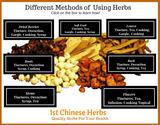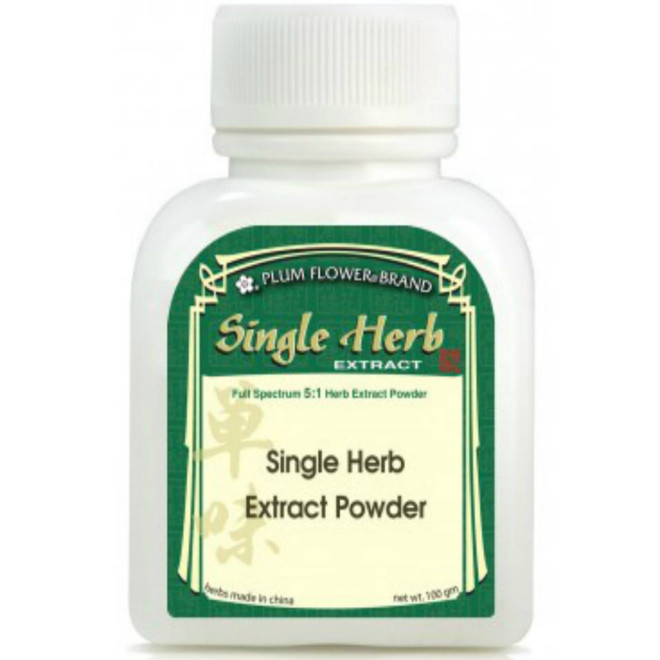Herbal information on Acanthopanax Root Bark in Bulk Powder Concentrate Form
Common Names: Acanthopanax Root Bark,
Botanical Name: Acanthopanax gracilistylus root-bark
Channels/Meridians: Liver, Kidney
Other Names: Cortex Acanthopanacis Gracilistyli Radicis, Acanthopanax spinosus
Pin Yin Name: Wu Jia Pi
Other Ingredients: Dextrin (derived from non-GMO corn)
Package Size: 100 grams
Form: Powder Concentrate
Dosage: Follow doctor's instructions on how to use this herb.
Brand: Plum Flower
Origin: China
Cautions: Do not use if pregnant or nursing. Acanthopanax shouldn’t be used with deficient and / or excessive heat syndromes. Do not use long term.
How to use Acanthopanax gracilistylus root-bark? The most commonly used method is in wine. The medicinal liquor is ideal for the winter season.
Product Properties: Bitter, Spicy, Warm
Naturally Occurring Chemical Components: syringin, stearic acid, d-sesamin, vitamin A, vitamin B, calcium oxide, palmic acid, kaurenolic acid, beta-sitosterol, stigmasterol
Although this item is still is stock, Wu jia pi/acanthopanax bark is now unavailable commercially as it has been over-cultivated and Xiang jia pi/periploca sepium bark is the acknowledged substitute herb in many formulas. As Xiang Jia Pi grows in the north, it is also known as northern Wu Jia Pi. Xiang Jia Pi is bitter, warming, and has similar properties to Wu Jia Pi. However, Xiang jia pi/periploca sepium is toxic and cannot be used interchangeably with Wu Jia Pi. It is also not recommended for long term use. Practitioners should be careful not to over-dose. (1.5-3 gm is the recommended dosage).
What Herbs combine with Acanthopanax Root Bark?
- Niu Xi and Acanthopanax Root Bark
- Dang Gui and Acanthopanax Root Bark
- Du Zhong and Acanthopanax Root Bark
- Gui Jia and Acanthopanax Root Bark
- Mu Gua and Acanthopanax Root Bark
- Chen Pi and Acanthopanax Root Bark
- Da Fu Pi and Acanthopanax Root Bark
- Jiang Pi and Acanthopanax Root Bark
Check out our How to Use Bulk Herbs page to see how to use herbs correctly. Our web page is constantly expanding, as of today we have articles on:
- How to make salves, poultice, tinctures, teas, capsules, gargles, and foot bathes
- How to make a citrus facial splash
- Cayenne pepper: Caterpillar and aphid spray ( Natural insect repellent )
- Citrus potpourri basket
About Plum Flower Quality Herb Powders
Plum Flower is an established worldwide manufacturer of high-quality Chinese herbs, and innovative Chinese medicinal herbs and products. Plum Flower uses sulfur-free herbs and laboratory tests its products for contamination and heavy metals, such as mercury, lead, and pesticides.
- Made at GMP internationally certified facilities (Good Manufacturing Practices) Quality control tests are done at the manufacturing site and at third party labs to confirm results.
- Manufactured using Unsulfured, Chlorine free, Aluminum Phosphate free herbs when possible.
- Microbials and heavy metals tested. No preservatives.
Manufacture's Statement: It is important to note that Plum Flower formula extract powders do not contain any excipients. They are spray-dried directly from the condensed herbal decoction, and the resulting powder is the natural yield of the formulation. Individual herbs can vary significantly in the amount of dissolved solids they yield during extraction. Many do not have the needed substance to form a powder, and our single herb extract powders contain a pharmaceutical-grade, non-GMO corn-based dextrin when necessary.
Traditional Chinese Herbs
Chinese Traditional herbs should be regarded as an added feature to modern western healthcare, and not as a replacement. Chinese traditional herbs (Teas) emphasize harmony, and balance.
Refereces:
http://alternativehealing.org/wu%20jia%20pi.htm
https://herbpathy.com/Uses-and-Benefits-of-Acanthopanax-Root-Bark-Cid3780
https://www.americandragon.com/Individualherbsupdate/WuJiaPi.html

















